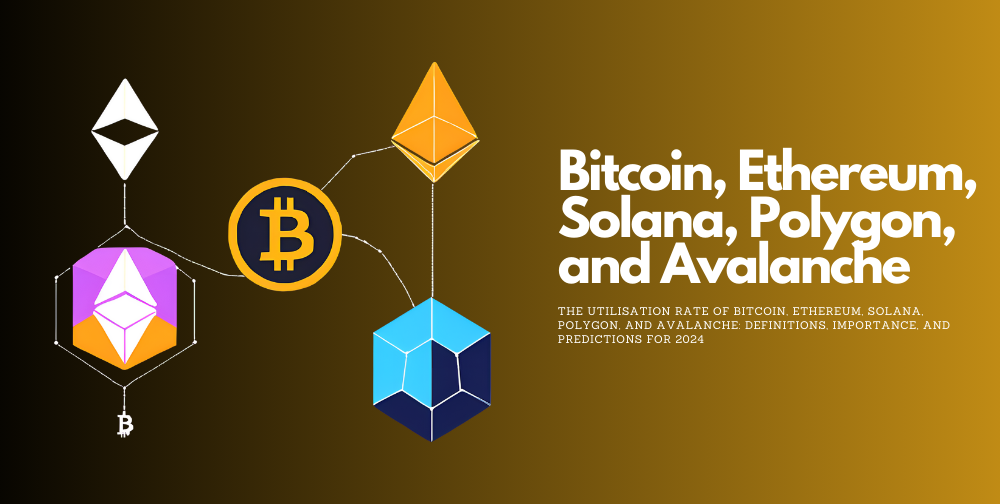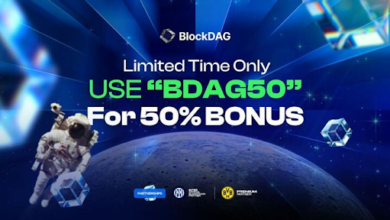The Utilisation Rate of Bitcoin, Ethereum, Solana, Polygon, and Avalanche: Definitions, Importance, and Predictions for 2024

Cryptocurrencies have surged in popularity over recent years, with Bitcoin, Ethereum, Solana, Polygon, and Avalanche emerging as some of the most prominent players in the digital asset space. These cryptocurrencies have gained traction due to their unique features, technological advancements, and the promise of a decentralized financial ecosystem. This article will explore the concept of the utilisation rate of these cryptocurrencies, its importance, factors influencing it, and predictions for 2024.
The Growing Popularity of Cryptocurrencies
Bitcoin (BTC)
Bitcoin, created by the pseudonymous Satoshi Nakamoto, is the first and most well-known cryptocurrency. It introduced the concept of a decentralized digital currency, enabling peer-to-peer transactions without the need for intermediaries like banks. Bitcoin’s popularity stems from its fixed supply of 21 million coins, making it a potential hedge against inflation and a digital store of value.
Ethereum (ETH)
Ethereum, introduced by Vitalik Buterin, expanded the possibilities of blockchain technology by enabling smart contracts and decentralized applications (dApps). Ethereum’s programmable blockchain allows developers to create a wide range of applications, from decentralized finance (DeFi) to non-fungible tokens (NFTs), significantly increasing its utility and adoption.
Solana (SOL)
Solana is known for its high throughput and low transaction costs. It uses a unique consensus mechanism called Proof of History (PoH), which, combined with Proof of Stake (PoS), allows for fast and cheap transactions. Solana has become a preferred platform for DeFi projects and dApps, contributing to its growing popularity.
Polygon (MATIC)
Polygon, formerly known as Matic Network, is a Layer 2 scaling solution for Ethereum. It aims to solve Ethereum’s scalability issues by providing faster and cheaper transactions. Polygon’s interoperability and compatibility with Ethereum have made it an attractive option for developers looking to scale their applications.
Avalanche (AVAX)
Avalanche is a platform for creating custom blockchain networks and decentralized applications. It boasts high throughput, low latency, and compatibility with Ethereum, allowing developers to deploy Ethereum dApps on Avalanche with minimal changes. Avalanche’s flexibility and efficiency have led to increased adoption in various sectors.
Defining Utilisation Rate
The utilisation rate of a cryptocurrency refers to the percentage of its supply that is actively used in transactions, smart contracts, or other applications. It is a crucial metric for understanding the adoption and real-world use of a cryptocurrency. High utilisation rates indicate that a significant portion of the cryptocurrency’s supply is being used for its intended purposes, rather than being held as an investment.
Importance of Tracking Utilisation Rate
1) Adoption Indicator: A high utilisation rate suggests widespread adoption and integration of a cryptocurrency into various applications and services.
2) Network Health: Monitoring utilisation rates helps assess the health and vibrancy of a cryptocurrency’s network.
3) Investment Insights: Investors can use utilisation rates to gauge the potential long-term value and stability of a cryptocurrency.
4) Regulatory Understanding: Regulators can track utilisation rates to understand the impact of cryptocurrencies on the economy and develop appropriate policies.
Factors Influencing Utilisation Rates
Market Conditions
Market conditions play a significant role in determining the utilisation rates of cryptocurrencies. In bullish markets, increased investor confidence and speculative trading can drive up utilisation rates. Conversely, bearish markets may see a decline in utilisation as trading activity slows down.
Network Usage
Network congestion and transaction fees can impact utilisation rates. High network congestion can lead to increased transaction fees and slower processing times, deterring users from transacting. Improvements in scalability and efficiency can boost utilisation rates by making transactions faster and cheaper.
Technological Developments
Technological advancements such as upgrades to consensus mechanisms, scalability solutions, and interoperability can enhance a cryptocurrency’s utility and drive higher utilisation rates. For example, Ethereum’s transition to Ethereum 2.0 and the implementation of sharding are expected to significantly improve its scalability and utilisation.
Regulatory Environment
Regulatory changes can influence utilisation rates. Favorable regulations can encourage adoption and increase utilisation, while restrictive measures can hinder usage and drive down utilisation rates.
Bitcoin (BTC)
Bitcoin’s utilisation rate is expected to stabilize with moderate growth. Its role as a store of value and hedge against inflation will continue to drive adoption, particularly among institutional investors. Integration into payment systems and the development of Layer 2 solutions like the Lightning Network will also support increased utilisation.
Ethereum (ETH)
Ethereum’s utilisation rate is projected to rise significantly with the completion of Ethereum 2.0. The shift to a proof-of-stake consensus mechanism and the introduction of sharding will enhance scalability and reduce transaction costs, making Ethereum more attractive for developers and users.
Solana (SOL)
Solana’s utilisation rate is expected to grow rapidly due to its high throughput and low transaction costs. Its ecosystem of DeFi projects and dApps will continue to expand, driving higher utilisation rates.
Polygon (MATIC)
Polygon’s utilisation rate is anticipated to see substantial growth as more developers adopt its Layer 2 scaling solutions to mitigate Ethereum’s scalability issues. Its interoperability with Ethereum will remain a key driver of utilisation.
Avalanche (AVAX)
Avalanche’s utilisation rate is likely to increase as more projects leverage its unique consensus mechanism and cross-chain capabilities. Its flexibility and compatibility with Ethereum will continue to attract developers and users.
Challenges in Accurately Determining Utilisation Rates
Exchange Trading Volume Manipulation
Inflated trading volumes on exchanges can distort utilisation metrics, making it challenging to accurately measure true utilisation rates.
Off-Chain Transactions
Many transactions occur off-chain on Layer 2 solutions or centralized exchanges, making them difficult to track and incorporate into utilisation metrics.
Privacy Coins and Techniques
Privacy-enhancing technologies can obscure transaction data, complicating the accurate measurement of utilisation rates.

Strategies for Defining and Calculating Utilisation Rates
1) Blockchain Explorers: Tools like Etherscan for Ethereum and SolScan for Solana provide insights into on-chain activities, including transaction volumes and smart contract interactions.
2) On-Chain Analysis Tools: Platforms like Glassnode and Chainalysis offer detailed analytics on cryptocurrency usage, including metrics such as active addresses, transaction counts, and network activity.
3) Comparative Analysis: Comparing on-chain data across different blockchains helps in understanding relative utilisation rates and identifying trends.
Comparison of Utilisation Rates and Market Impact
Bitcoin vs. Ethereum
Bitcoin’s primary use case as a store of value results in lower transaction volumes compared to Ethereum, which is driven by its diverse applications in DeFi, NFTs, and smart contracts. Ethereum’s higher utilisation rate reflects its broader utility and active developer community.
Solana vs. Polygon
Solana’s high throughput and low transaction costs make it suitable for transaction-heavy applications, while Polygon’s interoperability with Ethereum provides scalability solutions for Ethereum-based dApps. Both platforms have unique strengths that contribute to their utilisation rates.
Avalanche’s Unique Position
Avalanche’s compatibility with multiple blockchains positions it uniquely in the market. Its ability to bridge different ecosystems can lead to higher utilisation rates as more projects adopt its flexible and efficient infrastructure.
Role of Utility and Real-World Use Cases
The utility of a cryptocurrency is a key driver of its utilisation rate:
- Bitcoin: Bitcoin’s utility as digital gold and a hedge against inflation supports its adoption in investment portfolios and remittance services.
- Ethereum: The backbone of DeFi, NFTs, and smart contracts, Ethereum’s broad utility drives high utilisation.
- Solana: Solana’s low fees and high speed make it suitable for DeFi, gaming, and real-time applications.
- Polygon: By providing scalability solutions, Polygon enhances the usability of Ethereum-based dApps, boosting its utility.
- Avalanche: Its flexibility and compatibility with Ethereum and other blockchains enable diverse use cases, from DeFi to enterprise applications.
Potential Future Developments
Regulatory Changes
Regulatory developments can significantly impact utilisation rates. Clear and supportive regulations can foster adoption, while restrictive measures can stifle growth.
Technological Advancements
Innovations in scalability, interoperability, and security can enhance utility and drive higher utilisation rates. For example, advancements in Layer 2 solutions and cross-chain technologies can improve transaction efficiency and user experience.
Market Dynamics
Market sentiment, driven by macroeconomic factors, technological breakthroughs, and geopolitical events, can influence utilisation rates. Positive developments can boost confidence and drive adoption, while negative events can dampen usage.
Institutional Adoption
Increased participation by institutional investors and corporations can significantly boost utilisation rates. Adoption by large financial institutions, corporations, and payment processors can drive mainstream acceptance and integration into everyday transactions.
Cross-Chain Interoperability
Solutions enabling seamless interactions between different blockchains can enhance the utility and adoption of cryptocurrencies. Cross-chain technologies that facilitate the transfer of assets and data across multiple blockchains can drive higher utilisation rates.
Conclusion
The utilisation rates of Bitcoin, Ethereum, Solana, Polygon, and Avalanche in 2024 will be shaped by a complex interplay of market conditions, technological advancements, regulatory environments, and real-world use cases. While challenges exist in accurately measuring these rates, ongoing developments in blockchain technology and data analytics are likely to provide clearer insights. Understanding and tracking utilisation rates will remain crucial for stakeholders, from investors to policymakers, in navigating the evolving landscape of cryptocurrencies. As these digital assets continue to integrate into various facets of the global economy, their utilisation rates will serve as a key metric of their success and impact.





